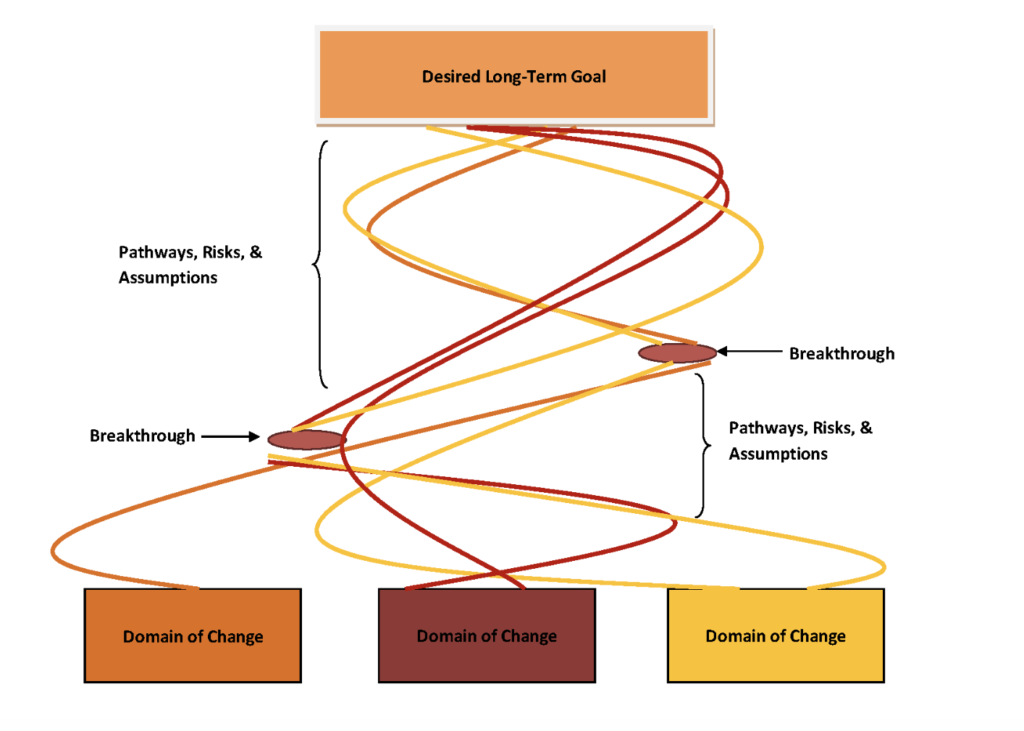Part I: Developing the Theory of Change
What is a Theory of Change?
A Theory of Change (TOC) is a set of hypotheses (if-then statements) represented through a set of pathways, critical assumptions and risks underpinning the design for how a desired long term goal will be achieved. In the context of a program, this generic definition is represented by the pathways of change which (a) flow from domains of change and (b) are marked by breakthroughs.

What are key considerations for developing a TOC for women's and girls' empowerment?
Women's and girls' empowerment is a social change process and this should underlie all phases of the theory of change – its design, measurement, and operationalization. Hence, the development of a theory of change for women's and/or girls' empowerment should:
- Be led by the ultimate aim of gender equity, making sure women’s empowerment is not narrowly conceived as working with and benefiting women exclusively.
- Invite partners from a broad spectrum into the discussion of the theory of change and its validation.
- Keep in mind both short-term and long-term perspectives of change, knowing that some gains will be achieved more quickly, while others will require seeds of change and invest in relationships with those who can help bring about the broader scope of change.
- Contextualize empowerment of women and girls through sound analysis that incorporates and elevates the perspectives of impact group members.
- Go beyond aspirations to achieve individual gender-equitable behavior to programming that builds equitable social norms and structures. This is the level at which social change is pitched. See the Gender Program Continuum.
Important lessons for CARE To draw from include: Reflections on Power and CARE's Women's Empowerment Framework
Ensuring the Quality and Robustness of the Theory of Change
A number of lessons learned emerge from the WEIMI CO experiences on how to ensure the quality and robustness of the theory of change, as in the following:
1. Invite diverse stakeholders to review the analysis and solicit their expert advice.
This can be done periodically, from the first draft of the problem tree or the vulnerability analysis underlying the selection of impacts groups, and at points in time during the development of domains of change, pathways, and measurement tools.
2. Prepare your vulnerability analysis, before selecting impact groups.
Make sure for “women and girls” the scope of the analysis starts broadly, at population level, rather than being specific to one group or region. Sources of data can include:
- Any prior assessments or studies within CARE that are still relevant to understanding underlying causes of poverty, social injustice and vulnerability.
- The Strategic Impact Inquiry results.
- A literature review that captures the broader picture of the situation for women and girls in the country.
- Any documentation from CARE’s or partners’ experience that contributes to a deeper understanding of the vulnerabilities and manifestations of poverty among women and girls. Prior gender analyses are particularly helpful
Once this information is assembled, it is then possible to begin a dialogue on impact groups and determine, for women and girls in this case, where the information gaps lie.
3. Document each and every reflection session, with full explanations on how the group arrived at decisions made in those discussions.
Each session may be attended by a slightly different set of people and good documentation will avoid opening up anew agreements made and justified.
4. Bring in gender expertise to review the theory of change or make sure the review includes a set of key gender questions.
This applies to a WE theory of change or a TOC with gendered elements.
CLICK HERE for Part I of the WEIMI Guide

WEIMI Guide
View the other sections of the WEIMI Guide:
